IBM uses 3D imaging to visualise patient records
- 27 September 2007
Researchers at IBM have developed new visualisation software that will allow doctors to view personal medical records on an animated human body.
Developed at IBM’s Zurich Research Lab, the Anatomic and Symbolic Mapper Engine (ASME) uses an avatar – a 3D representation of the human body – to allow doctors to see where a patient has injuries from their medical records.

Using the software, doctors can click on a particular part of the illustrated body and retrieve medical records with relevant information about any problems in this particular part.
IBM researcher Andre Elisseeff, told E-Health Insider: “It’s like Google Earth for the body. In hopes of speeding the move toward electronic healthcare records, we’ve tried to make information easily accessible for healthcare providers by combining medical data with visual representation, making it as simple as possible to interact with data that can improve patient care.
“The idea came out of a discussion we had with developers from Acure, a Danish company we recently acquired. We wanted to create a system that would help staff identify risks quicker, based on a patient’s past history. Associating this with a graphical image seemed the easiest way to do this.”
When a patient visits a doctor’s surgery today and complains of an illness, the doctor will ask the patient about any history the patient can recall, do tests, and visually and physically examine the patient.
They then have to search through records to see if a patient has any previous medical history that could be contributing to the symptoms.
However, using the 3D avatar, the doctor will be able to click on the body part where the pain is occurring, and see all available medical history and information relating to the area, including text entries, lab results and medical images.

The software is currently in prototype phase and is the result of collaboration between IBM Denmark and IBM Research.
“At the moment, we have been working on this prototype for a year and the functionality works. The software is built on top of IBM Denmark’s Electronic Health Records software and uses a standard image that can be clicked to see records relating to body parts. It is still under development at this stage with more interfaces and elements to go,” said an IBM spokesperson. “ASME allows navigating through a virtual map of the human body, an intuitive approach for healthcare professionals.”
If the doctor knows the exact area where the pain is coming from, they can zoom in on the area and narrow the search parameter for the information that is subsequently displayed.
IBM says the research, conducted at the Zurich Research Lab, is “trying to make information easily accessible for healthcare providers by combining medical data with visual representation, making it as simple as possible to interact with data that can improve patient care in an entirely new way.”
Using advanced machine learning and state-of-the-art 3D modelling techniques, the IBM researchers overcame key technical challenges including integrating heterogeneous data sources and complex text-based information–so-called unstructured data–and linking that data to the anatomical model in a meaningful and easy-to-navigate way.
The company says: “Building on previous IBM healthcare IT milestones, ASME is the medical information hub that semantically integrates information from IBM’s Health Information Exchange (HIE) with a virtual model of the human body. Moving forward, the researchers will explore integrating speech technology into ASME.”
A full version is scheduled for release in September next year, pending the success of the initial pilot tests. Currently in beta testing mode, the prototype requires more interfaces and elements before the functionality is fully available.
Work is also being done to ensure that customers who want it, have a version equipped to their electronic health record formatting. ASME will be capable of using SNOMED, the method of coding that will be used in electronic patient records globally, to create a bridge between graphical concepts and text documents.
Elisseeff added: “It will be up to the individual users if they want to use this system or not in addition to their electronic health records. What we have already seen though, is that by linking records with visualisation, users can easily get to the bottom of problems that would otherwise involve record investigations and repetitive questioning of patients.”
Links
Joe Fernandez




